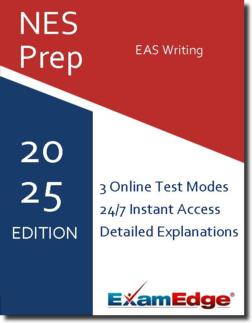NES EAS Writing (002) Practice Tests & Test Prep by Exam Edge - Topics
Based on 20 Reviews
- Real Exam Simulation: Timed questions and matching content build comfort for your NES EAS Writing test day.
- Instant, 24/7 Access: Web-based NES Essential Academic Skills Writing practice exams with no software needed.
- Clear Explanations: Step-by-step answers and explanations for your NES exam to strengthen understanding.
- Boosted Confidence: Reduces anxiety and improves test-taking skills to ace your NES Essential Academic Skills Writing (002).

Understanding the exact breakdown of the NES Essential Academic Skills Writing test will help you know what to expect and how to most effectively prepare. The NES Essential Academic Skills Writing has multiple-choice questions The exam will be broken down into the sections below:
| NES Essential Academic Skills Writing Exam Blueprint | ||
|---|---|---|
| Domain Name | % | Number of Questions |
| Mulitple-Choice | 75% | 27 |
| Understand purpose, audience, organization, and development in writing. | ||
| Understand problems in sentence formation. | ||
| Understand conventions of Standard Written English grammar, usage,and mechanics. | ||
| Written | 25% | 9 |
| In response to an assignment, demonstrate the ability to compose a developed composition in Standard Written English on a given topic. |
||


